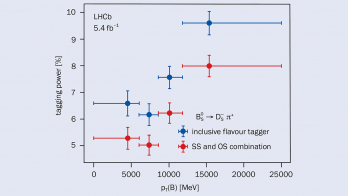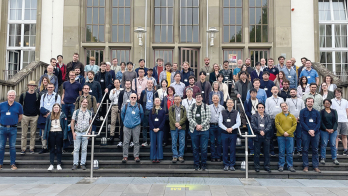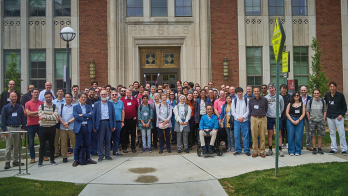
The LHCb collaboration has released a much anticipated update on its measurement of RK – a ratio that describes how often a B+ meson decays to a charged kaon and either a μ+μ– or an e+e– pair, and therefore provides a powerful test of lepton universality. The more precise measurement, officially revealed at Rencontres de Moriond on 22 March, suggests that the intriguing current picture of flavour anomalies persists.
Since 2013, several results involving the decay of b quarks have hinted at deviations from lepton universality, a tenet of the Standard Model (SM), though none is individually significant enough to constitute evidence of new physics. LHCb has studied a number of ratios comparing b-decays to different leptons and also sees signs that something is amiss in angular distributions of B→K*μ+μ− decays. Data from BaBar and Belle add further intrigue, though with lower statistical significances.
The latest measurement from LHCb is the first lepton-universality test performed using part of the 13 TeV Run 2 data set (2015–2016) together with the full Run 1 data sample, representing in total an integrated luminosity of 5fb-1. The blinded analysis was performed in the range 1.1<q2<6.0 GeV2, where q2 is the invariant mass of the μ+μ– or e+e– pair. It found RK = 0.846+0.060 –0.054 (stat) +0.016 –0.014 (syst), the most precise measurement to date. However, having shifted closer to the Standard Model prediction, the value leaves the overall significance unchanged at about 2.5 standard deviations.
“I cannot tell you if lepton-flavour universality is broken or not, so sorry for this!” said Thibaud Humair of Imperial College London, who presented the result on behalf of the LHCb collaboration. “All LHCb results for RK are below SM expectations. Together with b → sμ+μ− results, RK and RK* constitute an interesting pattern of anomalies, but the significance is still low,” he said.
Humair’s talk generated much discussion, with physicists pressing LHCb on potential sources of uncertainties and other possible explanations such as the dependence of RK on q2. Other experiments also showed new measurements of lepton universality and other related tests of the Standard Model, such as ATLAS on the branching ration of Bs→μ+μ− and an update from Belle on both RD(*) and RK*. The current experimental activity in flavour physics was reflected by several talks at Moriond from theorists.
“It’s not a discovery, but something is going on,” says David Straub of TUM Munich, who had spent the previous 24 hours working solid to update a global likelihood fit of all parameters relevant to the b anomalies with the updated LHCb and Belle results. The fit, which involves 265 observables showed that b → sl+l– observables such as RK continue to show a “large pull” towards new-physics. “The popular ‘U1 leptoquark’ is still giving excellent fit to the data”, says Straub.
Further reduction in the uncertainty on RK can be expected when the data collected by LHCb in 2017 and 2018 are included in a future analysis. Meanwhile, in Japan, the Belle II physics programme has now begun in earnest and the collaboration is expected to bring further statistical power to the b-anomaly question in the near future.
Further reading
LHCb Collaboration 2019 arXiv:1903.09252.








